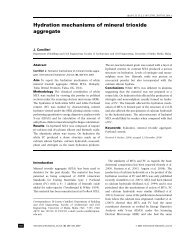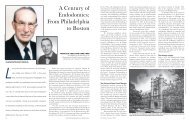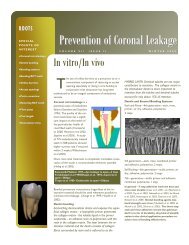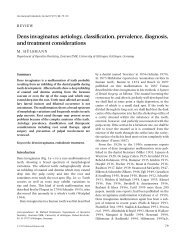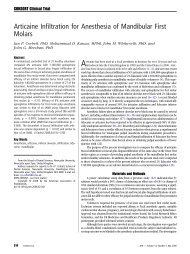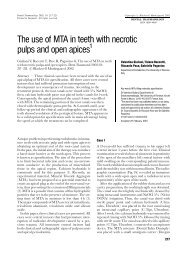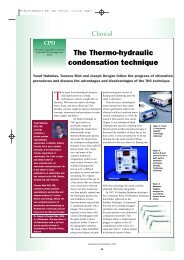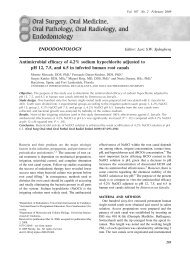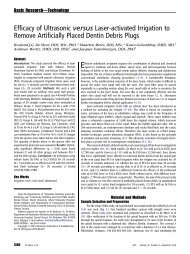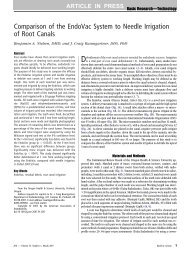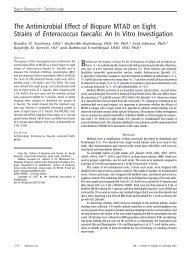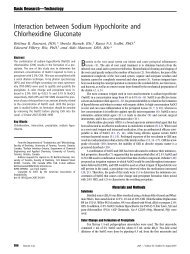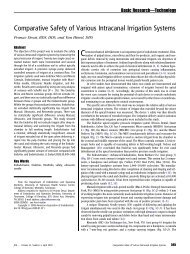Journal of Dental Research - The EndoExperience
Journal of Dental Research - The EndoExperience
Journal of Dental Research - The EndoExperience
Create successful ePaper yourself
Turn your PDF publications into a flip-book with our unique Google optimized e-Paper software.
Vo 1 54 1975<br />
vaginated within the cytoplasm <strong>of</strong> a Schwann<br />
cell. <strong>The</strong> plasma membrane <strong>of</strong> this latter<br />
cell constitutes typical mesaxons. A basement<br />
membrane is seen around the amyelinated<br />
nerve fibrils, which are more numerous near<br />
the subodontoblastic layer <strong>of</strong> the pulp chamber.<br />
In the plexus <strong>of</strong> Raschkow, both types<br />
<strong>of</strong> nerve fibers can be seen loosing their<br />
Schwann cell covering and their basement<br />
membrane, and close contacts between fibroblasts<br />
and odontoblasts have been observed.0<br />
Myelinated fibers can also loose their myelin<br />
sheaths.6 In the coronal dentin, some nerve<br />
fibers pass between the odontoblasts and<br />
reach the predentin and inner dentin.<br />
<strong>The</strong> odontoblasts in normal adult dentin<br />
may have different ultrastructural aspects.<br />
When engaged in secretory activities, the<br />
cell has a well-developed Golgi zone located<br />
along the dentinal side <strong>of</strong> the nucleus<br />
with different types <strong>of</strong> vesicles, vacuoles, and<br />
elongated and multivesicular bodies. This<br />
Golgi zone is surrounded by a rich endoplasmic<br />
reticulum with numerous mitochondria<br />
containing dense calcium granules.<br />
Micr<strong>of</strong>ilaments and microtubules are disseminated<br />
in the cytoplasm. When engaged<br />
in catabolic activities, large lysosomelike<br />
structures are visible within the odontoblast<br />
which can also take the aspect <strong>of</strong> a resting<br />
cell with just a few organelles. <strong>The</strong> lateral<br />
surfaces <strong>of</strong> these cells are connected by desmosomes,<br />
whereas toward the predentin these<br />
surfaces are attached by a junctional complex<br />
consisting <strong>of</strong> a desmosome, an intermediary<br />
junction, and a tight junction located<br />
near the predentin. In tile lateral<br />
intercellular spaces, some collagen bundles<br />
as well as some nerve fibers can be observed.<br />
<strong>The</strong> odontoblast process, a cellular extension<br />
<strong>of</strong> the odontoblast, extends through<br />
predentin and dentin. Brannstrom and<br />
Garberoglio,7 through use <strong>of</strong> a scanning electron<br />
microscope, observed that these processes<br />
in young human premolars were only<br />
found within a distance from the pulp equaling<br />
about one-quarter <strong>of</strong> the total length <strong>of</strong><br />
the tubule. With transmitted electron microscopy,8<br />
most <strong>of</strong> the dentinal tubules near the<br />
human dentinoenamel junction showed absence<br />
<strong>of</strong> odontoblastic processes; however, in<br />
young human premolars, hyaline peripheral<br />
degenerescence <strong>of</strong> these processes was observed.<br />
Bound by a plasma membrane, the cyto-<br />
Downloaded from<br />
http://jdr.sagepub.com by on January 29, 2010<br />
DENTIN AND PULP REACTIONS B177<br />
plasmic process at the level <strong>of</strong> predentin<br />
and inner dentin contains numerous microtubules<br />
and micr<strong>of</strong>ilaments with few organelles.<br />
Elongated small granules, associated<br />
with transfer <strong>of</strong> collagen9'10 and ground substance<br />
precursors"l during dentinogenesis,<br />
are rarely seen in adult dentin. In the latter,<br />
large vacuoles with light or dense contents,<br />
which seem to be associated either with<br />
exocytosis or endocytosis,12 are observed at<br />
different levels <strong>of</strong> the odontoblast and its<br />
process. At the peripheral extremity <strong>of</strong> the<br />
process, centrally located large vacuoles, with<br />
light cores, are associated with a hyaline<br />
cytoplasmic degenerescence <strong>of</strong> the process.13<br />
Lateral cytoplasmic processes penetrate in<br />
lateral b)ranching <strong>of</strong> the tubule.<br />
<strong>The</strong> odontoblast process does not fill the<br />
tubular lumen and between the odontoblast<br />
process and the calcified wall <strong>of</strong> the tubule,<br />
a periodontoblastic space is visible.'3 In<br />
the inner dentin, it contains a few uncalcified<br />
collagen bundles in areas where the<br />
tubular walls are made up by intertubular<br />
dentin. In addition, this space as well as the<br />
peripheral lumen <strong>of</strong> the tubules devoided<br />
<strong>of</strong> odontoblast process (dead tracts) are filled<br />
with the so-called dentinal fluid,14 which<br />
lhas the composition <strong>of</strong> interstitial fluid.15"16<br />
<strong>The</strong> odontoblast process is suspended in this<br />
fluid phase.<br />
At a certain distance from the predentindentin<br />
border, the wall <strong>of</strong> the dentinal<br />
tubule is made up <strong>of</strong> hypercalcified peritubular<br />
dentin, which, in comparison to intertubular<br />
dentin, contains more minerals,<br />
fewer collagen fibrils, and more ground substance.<br />
Even in normal conditions, the<br />
dentinal lumen can be completely occluded<br />
by apatitic mineralization.9 This dentinal<br />
sclerosis, also observed in transparent dentin<br />
during the carious process,17 also can occur,<br />
in this latter case through deposition <strong>of</strong><br />
rhombohedral crystals consisting <strong>of</strong> PCa3-<br />
(P04) 2 whitlockite.18 It is important to<br />
note that in an area <strong>of</strong> dentinal sclerosis, all<br />
tubules are not occluded and some scattered<br />
lumens remain permeable.17<br />
In recent years, important progress has<br />
been made in the understanding <strong>of</strong> the morphological<br />
basis <strong>of</strong> dental innervation. <strong>The</strong><br />
most convincing evidence for dentin innervation<br />
using light microscopy has been established<br />
by Fearnhead,19 and recently confirmed<br />
by Kerebel20 and Langeland, Yagi,



